 That swig of beer may come with more than alcohol and hops — it may also contain a dose of tiny plastic particles, reveals a new study in the journal Food Additives & Contaminants: Part A.Scientists refer to these little fragments as “microplastics,” since they’re less than one-fifth of an inch long.
That swig of beer may come with more than alcohol and hops — it may also contain a dose of tiny plastic particles, reveals a new study in the journal Food Additives & Contaminants: Part A.Scientists refer to these little fragments as “microplastics,” since they’re less than one-fifth of an inch long.
The researchers tested 24 brands of German beer for microplastics, and found that every last bottle was contaminated with the stuff. (Another gross-out factor: One brand even contained a nearly whole insect, and three had glass shards floating around.)
So how does plastic make its way into so many brews? The contamination most likely happens during the filtration and bottling processes, study author Gerd Liebezeit, Ph.D., told Yahoo Health. “There is evidence from the literature that filter material can be found in beer,” he said. “And tap water used for washing beer bottles before filling may also contain small amounts of particles.” Although his study was conducted in Germany, the beer production process is fairly universal across the globe — at least among large producers — said Liebezeit, who noted, “This problem probably occurs everywhere.”
And it’s not just beer you have to worry about. “Microplastic contamination is everywhere — in the air, in fresh and ocean waters, in the aquatic food chain, in human food,” said Liebezeit. That means we’re likely ingesting the tiny bits of plastic through multiple routes; research has so far detected microplastics in honey, soda, tap water, and some types of seafood.
There are two types of microplastics: First are the little fragments created when trash, such as plastic bags, breaks down. Then there are the microbeads found in cosmetics and toiletries, like toothpaste and facial scrubs, said Kirk Havens of the Center for Coastal Resources Management at the College of William and Mary, who researches microplastics. Both make their way into our water supply—and can infiltrate food-manufacturing processes (as with beer), or are consumed by marine organisms, such as mollusks.
The tiny fragments readily absorb harmful chemicals, such as pesticides, also contaminating the water. “If you get enough organisms consuming [the microplastics], and they get eaten by larger organisms, they ultimately get into the food web that we as humans are interested in eating,” explained Havens. Case in point: If you eat just six mussels, you’ll take in about 90 microplastic particles, according to a new study in Environmental Pollution. Six oysters equals around 50 particles. The researchers estimate that serious shellfish consumers take in up to 11,000 bits of plastic per year.
Does this pose a risk to human health? “That’s still an uncertainty,” said Havens. As the authors of the Environmental Pollution study write, “Due to the complexity of estimating microplastic toxicity, estimations of the potential risks for human health posed by microplastics in food stuffs is not yet possible.” However, animal studies have shown that microplastic particles are able to pass from the gut into surrounding tissue, causing inflammation, and that hazardous chemicals hitching a ride on the particles may, in fact, be absorbed into the body, said Liebezeit. “Allergic reactions may possibly also result from exposure to contaminant-laden microplastics,” he added.


No comments:
Post a Comment